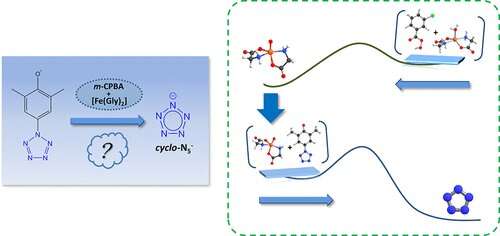https://doi.org/10.1021/acs.jpclett.9b03762 Copyright © 2020 American Chemical Society
Recently, a research team led by Prof. Liu Jianyong and Prof. Han Keli from the Dalian Institute of Chemical Physics (DICP) of the Chinese Academy of Sciences unraveled the synthetic mechanism of the novel energetic material of cyclo-N5- salt. Their results were published in the Journal of Physical Chemistry Letters.
Compared with the traditional C, H, N, O-based energetic materials, polynitrogens have higher chemical energy storage and no pollution, making them one of the most promising candidates for the novel high energy material.
In 2017, the bulk-synthesis of cyclo-N5- salt from arylpentazole through the treatment of Fe(Gly)2 and m-CPBA was achieved. However, the low production yield and the unknown reaction mechanism restrict the application of cyclo-N5- as energetic material.
The researchers carried out an in-depth mechanistic study on the synthesis of cyclo-N5-. They studied the synthesis of arylpentazole, which is the precursor of cyclo-N5-, gave the complete synthetic mechanism of arylpentazole, and discussed the substituent effect. These results revealed the proper structure and reaction condition for arylpentazole production with higher yield.
Based on the above results, the present study unveiled the mechanism of selective C-N bond cleavage in arylpentazole. The high-spin state ferrous bisglycinate (Fe(Gly)2) is firstly oxidized by m-CPBA, leading to the formation of a high-valent iron(IV)-oxo complex. This Fe(IV)-oxo intermediate can effectively rupture the C-N bond in arylpentazole while keeping the pentazole ring intact.
Besides, the π-π stacking effect between arylpentazole and m-CPBA promotes the formation of dimmers and trimers, which hinders the Fe-oxo from attacking the C-N bond of arylpentazole. How to effectively obtain iron(IV)-oxo structure is the key to increase the yield of cyclo-N5-.
This study provides valuable theoretical guidance for the efficient synthesis of cyclo-N5-. It was supported by the Science Challenge Project and the National Natural Science Foundation of China.
More information: Fangjian Shang et al. Unraveling the Mechanism of cyclo-N5- Production through Selective C–N Bond Cleavage of Arylpentazole with Ferrous Bisglycinate and m-Chloroperbenzonic Acid: A Theoretical Perspective, The Journal of Physical Chemistry Letters (2020). DOI: 10.1021/acs.jpclett.9b03762
Journal information: Journal of Physical Chemistry Letters
Provided by Chinese Academy of Sciences
























